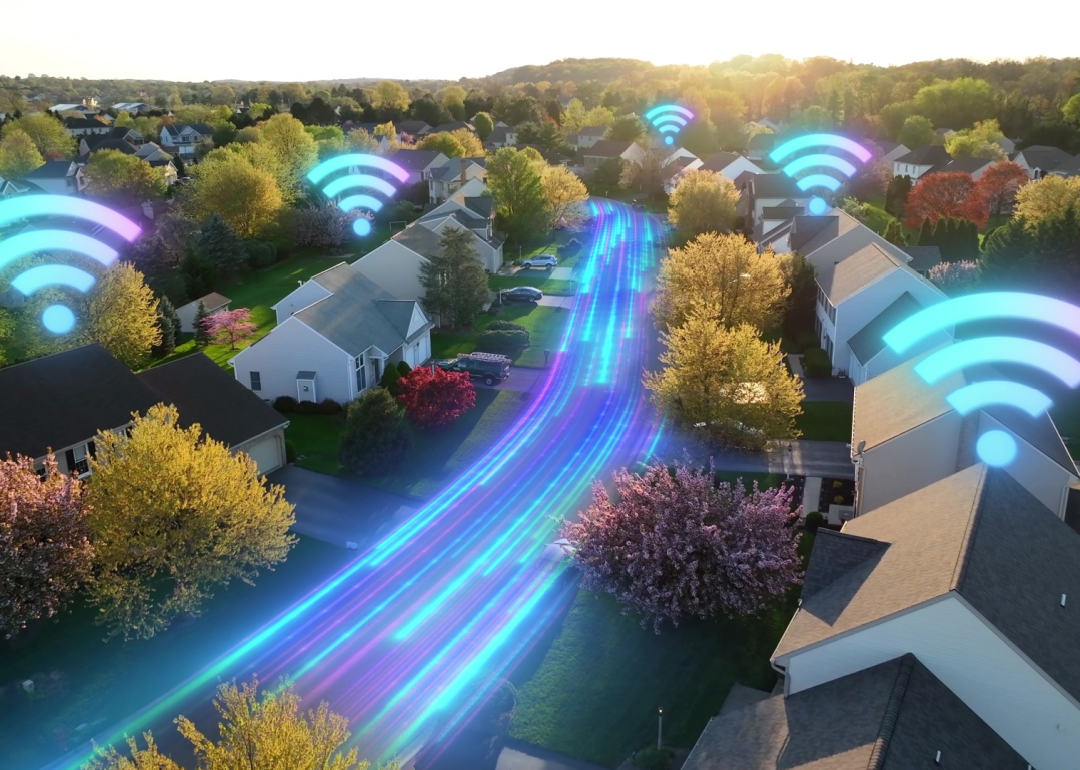
Connected or left behind? How digital access varies across US states in 2025
Connected or left behind? How digital access varies across US states in 2025
In 2025, connectivity to the internet is nearly as important to life as electricity. People rely on it for their social identity, communication, information, and economic opportunity. However, despite its importance, there are still many who are left behind and face barriers to achieving connectivity.
Some states have substantially higher rates of internet connectivity than others. This can be linked to a range of socioeconomic causes, and this has an impact on American society as a whole. Using data from the Census, the Pew Research Center, and industry trends, That’sThem examined how each state ranks using a composite digital connectivity index score.
The methodology for the state digital connectivity index
Data points for this report were compiled using a three-part composite scoring system. Information was gathered about household computer use from the Census Bureau’s American Community Survey.
Overall, there are three parts to the scoring system:
- Smartphone ownership (35% weight)
- Laptop/desktop ownership (30% weight)
- Overall device ownership, including tablets (20% weight)
- Internet subscriptions (15% weight)
The leaders in digital connectivity: State rankings chart
The chart below ranks each state in the categories listed above. In addition to their position in the chart and numerical values, colors correlate to the overall connectivity score. The darker the green, the higher the connectivity the state has. The darker the red, the lesser the connectivity.
It’s worth noting that despite the disparity between states at the top and bottom of this list, overall connectivity is still quite high compared to the rest of the world.

The most connected states
The Mountain West boasts very strong digital connectivity overall, with Utah and Colorado ranking first and second, respectively. Both of these states had some of the highest rates of computer and smartphone ownership. Due to the remoteness of some areas in these states, however, internet subscription scores were not as high as in more densely populated states.
Washington, Maryland, and California took the third, fourth, and fifth spots on this list. Each demonstrated high connectivity rates across all scoring metrics.
The least connected states
All five of the least connected states were located in the South. West Virginia ranked lowest on this list, with substantially lower smartphone ownership than even their neighbors. Computer ownership and internet subscription percentages were also lower.
Mississippi, Louisiana, Kentucky, and Arkansas are some of the other least connected states. Despite their rankings, though, they had much higher smartphone ownership percentages than West Virginia.
A divide in connectivity between rural and urban states
One of the biggest disparities outlined by this ranking is between rural and urban locations. States with large rural areas have significantly less infrastructure when it comes to internet subscriptions, including services like fiber. Smartphone connectivity with 4G and 5G can also be lacking.
While smartphone ownership across the U.S. is above 90%, the Pew Research Center has found that one in four rural Americans consider high-speed internet a top issue. Without high-speed internet, many people may forgo having devices like computers and tablets in their homes. This could explain many of the lower connectivity scores on this list.
Urban areas have significantly more resources when it comes to digital connectivity. While infrastructure is much more abundant, technological literacy is also higher, which directly correlates to comfort with technology and a variety of devices.
Who’s getting left behind with digital disconnectivity?
A few key descriptors are common when analyzing the groups of people most affected by this “digital divide.” For one, a rural residence is one of the biggest predictors of having a low connectivity score. Besides location, there are also other socioeconomic and demographic factors at play, suggests researchers in the Journal of Human Rights and Social Work:
- Lower-income individuals: Families who are below, at, or near the poverty line have a harder time affording digital devices and services like internet, computers, and tablets.
- Underserved populations: According to the most recent American Community Survey in 2021, Black and Hispanic households recorded the lowest percentages of computer, tablet, and smartphone ownership across all races in the U.S.
- Older individuals: In the same survey, individuals 65 years or older were substantially less likely to have digital devices or an internet service plan compared to younger age brackets.
For many of these groups, digital disconnectivity can also make it harder to verify or connect with others online. In such cases, tools like a people search can help individuals reconnect with family, classmates, or community members—even when traditional means of communication are limited.
How policy changes can increase connectivity across the country
In order to get the entire United States up to speed with digital connectedness, change is crucial. The key is prioritizing infrastructure improvements and policy reform.
More utilities must be installed in remote areas with low internet connectivity rates. This could involve adding cell phone towers in dead zones or adding fiber optics to telephone wires to carry broadband internet to homes. Both improvements would substantially enhance access.
Policy change is where real action starts. The federal government has already put funding in place to expand internet access through the Broadband Equity Access and Deployment Program. This $42.45 billion fund will be used to deploy or upgrade infrastructure in underserved areas, install Wi-Fi service in residential buildings, and conduct research for future improvements.
Improving connectivity and closing the divide
It has never been more essential for people to have access to digital devices and the internet. However, not all states and Americans have equal access. Many of the rural states in the southern U.S. are falling behind leading states like Utah, Colorado, and Washington, mostly due to socioeconomic reasons.
To close this large divide, infrastructure changes, policy reform, and digital education will be necessary to improve connectivity, raise digital literacy, and create a more interconnected and technologically adaptable society. And as more Americans come online, ensuring digital safety will be just as critical—starting with understanding who’s on the other end of your connections. When you receive calls or texts from unfamiliar numbers, a reverse phone lookup can help confirm if they’re legitimate or potentially fraudulent.
This story was produced by That'sThem and reviewed and distributed by Stacker.



